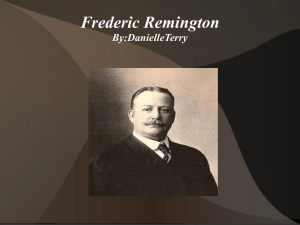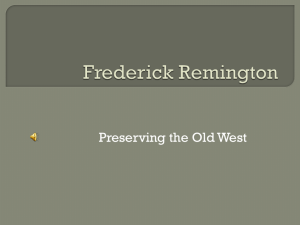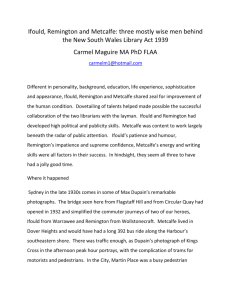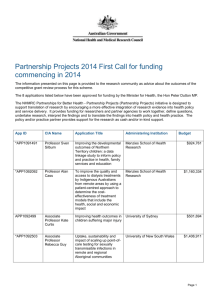three mostly wise men behind the New South Wales Library Act 1939
advertisement
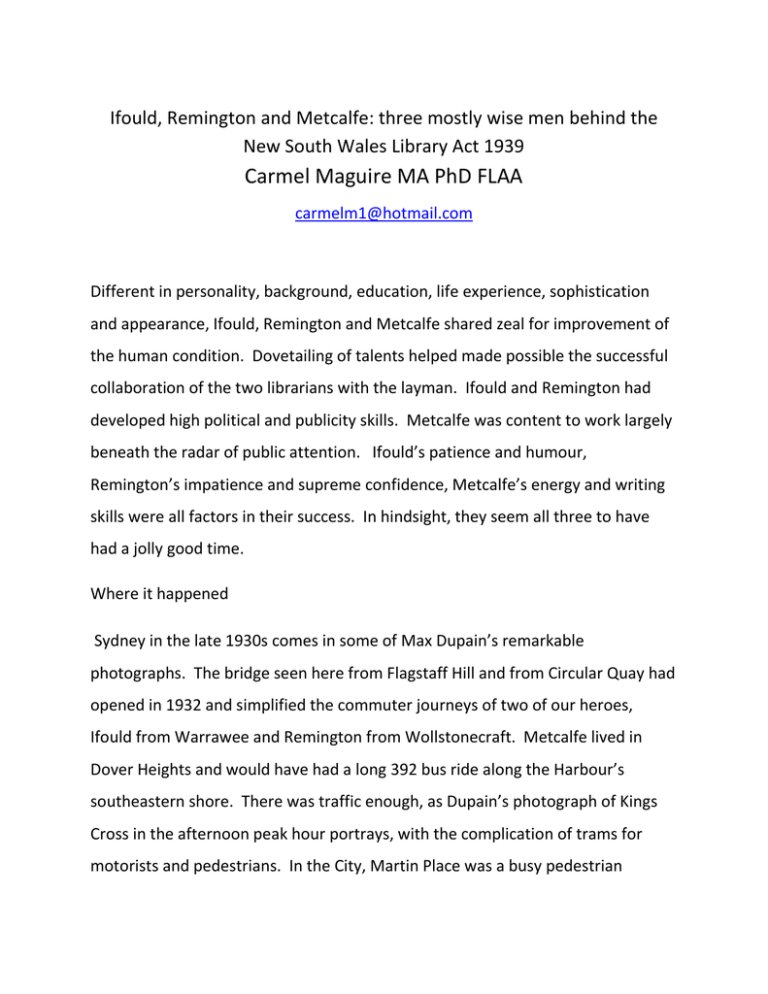
Ifould, Remington and Metcalfe: three mostly wise men behind the New South Wales Library Act 1939 Carmel Maguire MA PhD FLAA carmelm1@hotmail.com Different in personality, background, education, life experience, sophistication and appearance, Ifould, Remington and Metcalfe shared zeal for improvement of the human condition. Dovetailing of talents helped made possible the successful collaboration of the two librarians with the layman. Ifould and Remington had developed high political and publicity skills. Metcalfe was content to work largely beneath the radar of public attention. Ifould’s patience and humour, Remington’s impatience and supreme confidence, Metcalfe’s energy and writing skills were all factors in their success. In hindsight, they seem all three to have had a jolly good time. Where it happened Sydney in the late 1930s comes in some of Max Dupain’s remarkable photographs. The bridge seen here from Flagstaff Hill and from Circular Quay had opened in 1932 and simplified the commuter journeys of two of our heroes, Ifould from Warrawee and Remington from Wollstonecraft. Metcalfe lived in Dover Heights and would have had a long 392 bus ride along the Harbour’s southeastern shore. There was traffic enough, as Dupain’s photograph of Kings Cross in the afternoon peak hour portrays, with the complication of trams for motorists and pedestrians. In the City, Martin Place was a busy pedestrian thoroughfare when the ladies’ dresses were long and the gentlemen’s heads rarely uncovered.i The ‘one o’clock cannon’ boomed from Fort Denison while the mail was delivered four times a day in the city and twice a day in the suburbs. Sargents’ pie shops were everywhere with a large pie, tomato sauce, bread roll, butter, milk coffee or tea for one shilling. Business lunches cost one shilling and three pence.ii There was lots of parking in Macquarie Street which at least was free of trams but with a variety of vehicles wonderful to behold.iii Parliament House stood pretty much as it is today and the business of the legislators was pretty much the same. Their laws and regulations were carried out by the ‘humble and obedient servants’ in the New South Wales Public Service, whose probity was not questioned and whose salary scales had only been restored to their 1929 levels in 1937.iv Our heroes The three, mostly wise, men most responsible for the passing of the New South Wales Act 1939 differed in many ways. In physique, W.H. Ifould was a mere 5 feet 2 inches (132 cm) in height; Geoffrey Remington stood 5 feet 9 inches (175 cm) according to his Army measurement in 1918; John Metcalfe is remembered as about the same height. In the later 1930s, Ifould was nearing his sixties, twenty years older than the other two, who were on the cusp of their forties. All three were healthy specimens. There were differences among them in class and geographical origins, and in personality, sophistication and professional attainments. This paper explores the ways in which their differences and their similarities melded into the force behind the passing of the Library Act by the New South Wales Parliament in the early hours of 3 November 1939. William Herbert Ifould was born in 1877 on his family’s property in South Australia, the eighth child of a family described by his biographer as ‘of diverse interests, enterprises and attainments’.v Ifould’s father had migrated from England and prospered through hard work and acumen. At age 11 William Herbert was sent to school in Adelaide and he proved an impressive student, but his ideas of a university education immediately after school were stifled by the effects on his family of the sustained economic depression of the 1890s. In many families burnt by economic depression, sons were encouraged into government service and that is what happened to Ifould. By 1902 at age 25 he had distinguished himself especially for his work in cataloguing at the Public Library of South Australia, had been consulted interstate, and been promoted to the position of South Australia’s Deputy Librarian. He also studied in the evenings for a Bachelor of Arts degree at the University of Adelaide, but the demands of his library career impeded completion of his degree when from 1904 he was effectively in charge of the Public Library. The Institutes Association exerted a powerful influence over the libraries in schools of arts or institutes in that State, and the leading figures in the Association were dominant in other areas of South Australian public life, among the trustees of the Public Library for example. When he proceeded to the top job, their influence impeded some of Ifould’s initiatives. By the end of the decade he had had enough. Both his parents and his wife’s parents had died so that they could sever their attachment to the State. Not surprising then that Ifould applied for the advertised Principal Librarian position at the Public Library of New South Wales, and in mid 1912 he was appointed to the job.vi Geoffrey Cochrane Remington was also the son of a migrant father who had left Northern Ireland at 13. He prospered in the insurance industry in Sydney and married the boss’s daughter. Remington was the second surviving child of his parents whose first son had died during their extended honeymoon period in Europe. Most of his childhood was spent in a home designed by Holman Hunt and described in the architectural literature as ‘one of the most distinguished’ houses on Sydney’s North Shore.vii The Remington home was in the suburb of Warrawee where, by chance, Ifould established his family home from 1913 onwards. At the Remingtons, the atmosphere was both comfortable and godly, with servants, extensive grounds and daily prayers. His father’s suicide when Geoffrey was 10 years old must have been shocking. The sudden removal of a dominant personality must have affected his children but the family’s fortunes were not lessened. Geoffrey proceeded to boarding schools in the country. His prep school, Tudor House on the Southern Tablelands, later shared in the education of Patrick White who approved its ‘Australian temper’.viii The Armidale School and the Sydney Church of England Grammar School known as Shore, rounded out his high school education. John Metcalfe was himself an English migrant. He was born in Lancashire though he was only 10 years old when his family settled in Sydney in 1911. His parents were, in his own description ‘upper working class’.ix His father was the manager of a paper bag manufacturing plant and a man who liked making things with his hands. [One of the wooden stools he made was one of the treasured objects which filtered to staff at the UNSW School of Librarianship his son founded]. His mother was a dressmaker who made all John’s clothes. The depression of the 1930s put an end to his parents’ modest prosperity and their health. Metcalfe had done well in his education in State public schools and as an evening student at the University of Sydney. In 1923 he graduated as a Bachelor of Arts with firstclass honours in history. Metcalfe attained the highest formal educational qualifications of the trio. Remington’s career in high school seems to have been undistinguished according to the surviving records. Very soon after a few months in the Army in 1918, he was articled to Allen Allen and Hemsley, one of the great founding law firms in Sydney, the remains of which survive to this day. According to his own account – and there doesn’t seem to be any others extant – his progress in the examinations of the Solicitors Board was not brilliant, but he was admitted as a solicitor in the Supreme Court of New South Wales in 1923. Family affluence gave him the opportunity of setting up his own law firm in 1924, immediately on conclusion of his articles. Of the three, Remington was the nearest to being a playboy, rumoured to have been affianced to one of the Misses Allen, a club man with lifelong membership of the Union Club in Bligh Street. He was also a member of the Royal Sydney Yacht Squadron, and, like Ifould, a golfer. Remington was at the same time, like Metcalfe, a dutiful son, solicitous for the welfare of his mother and his aunt until their deaths in the 1920s. By mid 1930s Remington had travelled the world, numbered Beatrice and Sidney Webb among his acquaintance, taken a liking for the ideas of Fabian socialism, and had established a healthy practice almost all in commercial law. He had also acquired a beautiful wife, two children and a Savile Row tailor. He was a well-established contributor to the public discourse in newspapers and periodicals. He had also established the foundations of his networks in the media and in political and business circles. John Metcalfe was a rougher diamond. Anxious to ensure his suitability for promotion to the second top job in the Public Library of New South Wales, Ifould had arranged elocution lessons for him, which suggests that Metcalfe may have traces of a Lancashire accent when an identifiably Australian accent would probably not have been a help to success on the career ladder either. Metcalfe, like many North Country Englishmen, was not possessed of easy charm. In contrast, Ifould seems to have inspired affection tending towards devotion in his office staff. In the cramped quarters of the old Bent Street building, he shared jokes (like his references to Purnell, the head of the Public Library of South Australia as ‘the infernal Mr Purnell’) and kindnesses with the office staff, according to his secretary typist, Dulcie Penfold, who herself went on to become a distinguished public librarian.x The Library was handily situated next door to Ifould’s club, the Australian Club. Remington’s kindness was obvious in his dealings with employees, and he was hospitable to young people generally, even though some of the older women in librarian roles at the Public Library of New South Wales were wary of his charm and suspicious lest it betoken condescension. Without getting off the track here, let me acknowledge immediately that they were all three men of their time. Feminist ideas had not percolated. After all the New South Wales Public Service Board had been careful to exclude women from all but the most menial of positions. One historian has pointed out that ‘The Board hardened its attitude towards the employment of women after Wallace Wurth became chairman’ in 1939.xi It was already tough enough, since, well before then, the Board had justified employment of women as tracers in government drawing offices, and I quote, to ‘prevent mental stagnation’ in educated young men’.xiiIfould was the active player in grooming Metcalfe as his successor as Principal Librarian of the Public Library of New South Wales to avoid the awful possibility that the job could fall to a woman and Metcalfe would have raised no objection. Remington also betrayed no thoughts that top jobs were not to be reserved for gentlemen. There has been a trickle of biographical writing about them, but there is a fascinating slice of social history still to be mined in the lives of the early Public Library women.xiii Commitment to the public library cause Our three heroes took different paths to their commitment to the public library cause. Ifould’s zeal for public libraries had been fired in the political cauldron of South Australia where his opposition was unyielding to the Institutes Association and to the Library Association of Australasia, which remained wedded to the idea of subscription libraries. Both he and Metcalfe had made significant inputs into the Munn Pitt report on the libraries of Australia, funded by the Carnegie Corporation of New York, which was published in 1935.xiv Ifould already had in mind plans for a statewide network of public libraries based on his Library. Metcalfe’s entry into library work was by chance when he got a job in the Fisher library of the University of Sydney after his mother saw the advertisement. He liked the work from the start and when the opportunity arose he took a job with better prospects at the Public Library. Both Metcalfe and Ifould were well-placed by position, professional achievement and interest to see the relevance of the Free Library Movement when it began in Sydney in mid 1935. Remington was the wild card. Remington in mid 1930s was a man looking for a cause and he found it when Frank Tate, head of the Australian Council for Educational Research, handed him Munn and Pitt’s no-holds-barred report (entirely written by Munn) on the state of Australian libraries. Remington had gone to Melbourne as a side-kick to a fellow lawyer seeking Carnegie Foundation funds for the Australian Institute of Political Science. The Munn-Pitt report had just arrived from the printers and Tate offered Remington a copy as ‘something that you can get your teeth into’. Over a weekend Remington read it, and reported that he was ‘shocked at what it had to say and fascinated by the way it was said’.xv Back in Sydney he sought out John Metcalfe who was by then Deputy to Ifould’s Principal Librarian at the Public Library of New South Wales. The two of them quickly decided that a movement to promote free libraries had to be set up, with a layman as propagandist and librarians as the technical experts. Ifould’s initial reaction to their enthusiasm was perceived as skepticism by the other two. Remington thought Ifould doubted his persistence while Metcalfe believed that ‘Billy’ (as he later referred to him) was not quick to acknowledge his Deputy’s initiatives. Ifould, the seasoned and trusted public servant, diplomatic in his dealings with politicians, discreet in his public utterances, must have been well aware of the danger of endorsing the enthusiasm of a supremely confident outsider like Remington. But happily these hesitations were quickly overcome. Remington and Metcalfe needed Ifould’s prestige and his influence with the Minister of Education, David Herbert Drummond, as well as his expertise in dealing with Parliament and the State bureaucracy. On the other hand, Ifould was soon to appreciate Remington’s freedom of speech, exempt from the restrictions imposed upon himself and Metcalfe as public servants. The Free Library Movement proved an ideal vehicle for their campaign to get libraries for the people. It was founded in 1935 by a Sydney accountant, George W. Brain, who was later to become a Member of State Parliament. Under Brain’s guidance the Movement had achieved a constitution and a clear mission, which was ‘to advocate and work for the establishment of Free Libraries and to create and foster public opinion on the value of Free Libraries’xvi Attendance at the inaugural meetings had no lack of big names but the first two meetings were five months apart, and the Movement only came to vibrant life after a year when in March 1936 Remington took over as Chairman of the Executive. What they did: the Free Library Movement The battle for public libraries for the people was joined with great energy. Leading citizens of both sexes were recruited. Remington designed a grand campaign of publicity and public relations, with Metcalfe writing most of the texts. Members of Parliament, captains of industry, trade union leaders, leaders of community associations, and the general public were targets. No opportunity to speak at meetings was neglected. Remington and Metcalfe barnstormed the State, usually by train, to inaugurate groups in regional cities and towns. Rumour suggests that they rewarded their efforts with a drink or two after the meetings. Perhaps Mr Brain was not always delighted with the success of their proselytizing. Within three months he had to urge one librarian contact to ease up on spreading the word as ‘I am finding it almost impossible to keep up with correspondents as it is’.xvii Before the end of 1936, the Movement had its own office near Remington’s, with a full-time assistant secretary. Membership cost one shilling per year and was growing rapidly: the town of Casino for example boasted 500 members. Metcalfe and Remington wrote the Movement’s publications themselves and saw them through the press. They also wrote articles. The Movement’s Statement was published in Australian Quarterly in June 1937 and a constant barrage of press releases was fed to the metropolitan and country papers. Metcalfe drafted radio scripts and Remington dragooned several of his friends to join him in their delivery. Always operating on risible amounts of money, Remington roused his five Executive members to each put up £25 to guarantee an overdraft of £125 for Movement, and Ifould was one of the guarantors. Honorary Secretary Brain husbanded the funds they had, and so from the outset a dovetailing of talents was obvious, and it was needed when the Free Library Movement came to deal with the Library Group. Remington’s tact and tolerance were important elements in his successful networking. He displayed none of these qualities in his relations with the Library Group, the committee of librarians set up under ACER auspices to decide on the allocation any Carnegie Foundation funds granted for libraries. The Group comprised the state librarians of New South Wales, Victoria and South Australia and the Librarian of the Commonwealth National Library, with Frank Tate as Chairman. Ifould hoped to win the Group’s support for his case to Carnegie for the regional scheme for New South Wales he had worked out. From the start, Remington continued to communicate directly with Carnegie, and justified his barrage of correspondence with the Corporation head as necessary to convey ‘some of the colour and action of our work’ which would possibly be lost in the Group’s ‘formal and necessarily reserved reports’.xviii As always State jealousies came quickly to the fore. Some of the Group suspected that Ifould and Remington were in cahoots since the majority of Carnegie funds had flowed to New South Wales. Perhaps this reflects the Group’s reluctance to acknowledge that New South Wales was after all where almost all the action was. In the major fracas in the Group in 1940, a few months after the passing of the NSW Library Act, as in the minor skirmishes beforehand, Ifould retained his sang froid, as he coolly explained that Remington was reluctant to recognize that Carnegie moneys would and should be distributed on the advice of the Library Group.xix Ifould was not without guile since he was at the same time in touch with Carnegie regarding possibility of support for students at the library school he was setting up in his Library and for a new library building in Newcastle. In any case, the Library Group’s importance faded from the immediate scene in March 1937 when Ifould’s golfing partner, Education Minister Drummond, announced to the second AGM of the Free Library Movement that the Libraries Advisory Committee would be set up to draft a bill to enable free libraries to be set up throughout the State. What they did: the Libraries Advisory Committee With Ifould as its chair, Metcalfe was its secretary, and Remington and Brain were members. By Oct 1938, about eighteen months later, 36 meetings of the Committee had been held. Even after addition of help from a public servant adept in drafting bills for the Parliament, the exacting work was slow. Many feathers had to be smoothed for example in the local government circles where the dazzle of State government funds had to be accompanied with reasonable conditions to cover a great variety of circumstances. The traditional mistrust of levels of government for each other was another factor. Education Minister Drummond had to be convinced that local government could be trusted with involvement in the running of local libraries. The persuasion of the Minister fell mainly but not exclusively on Ifould. Remington weighed in with tactics, such as his threat to Drummond, which seemed plausible at the time, that South Australia would beat New South Wales with public library legislation. Remington also busied himself, not to say busybodied himself, in attempts to get the Free Library Movement going in other states. The ‘missionary journeys’ throughout New South Wales continued. Ifould in Inverell, before his Minister arrived, established his credentials with his audience not only as country born and bred but as the owner of a profitable orangery, which brought more income than his public service salary. He could also point to the practical benefits of library services from his own experience.xx Preparation of the Committee’s report called for weeks and months of work and negotiations. Metcalfe as Secretary to the Committee kept track of all the revisions in the drafts which were further pored over by Ifould. Even so, the matters to be decided were not trivial and there were delays as all Committee members had other commitments. At last the Report was ready and Drummond submitted it to Cabinet in November 1938, recommending its adoption and publication. The Minister displayed his good natured amusement when he received a note from Remington urging policy action on the Report even before Ifould had handed him a copyxxi Drummond did ask that no-one should be inspired to bring pressure on the Government to publish the Report until the Cabinet had had time to consider it.xxii By mid December, the Free Library Movement tried to stir the Premier, BSB Stevens, to action, with a resolution of its Council for a deputation of three to wait upon him to adopt a library policy, to complete the Public Library building and to make the LAC report available. With the resolution Remington enclosed a personal letter to the Premier letting him know that no deputation would be necessary if the report of the Libraries Advisory Committee had been made public. No deputation was ever necessary. Remington had roused every town and shire council in NSW to let the Minister know how many copies they wanted. In mid January, Drummond reported they were inundated with requests. At the end of January the Report was printed and two months later 5000 copies had been distributed.xxiii Minister Drummond in his foreword disclosed that the proposed bill had been approved in principle by Cabinet and that the necessary legislation should be passed in the current year.xxiv But the drama was by no means over. From mid 1939, the times for getting new legislation through the Parliament could hardly have been less propitious. Even Australia had woken up to the threat of war in Europe, with Germany in alliance with Italy and the Russians pledged in a non-aggression pact. On the home front the State Government was not stable, Premier Stevens resigned in August and Alexander Mair took over. The new Premier has been charitably described as of nervous disposition. Drummond remained as Minister for Education and preparation of the Library Bill was not abandoned. Even after Australia’s declaration of war with Germany on 3 September, the Library Bill remained in the lists until three weeks later when Cabinet resolved to defer it. Ifould offered Minister Drummond a way out, suggesting a delay in implementation of the Bill’s financial provisions to a date to be fixed. But his rage can be read in his extraordinary threat to his Minister that, if the Bill was deferred, he would give information to every important metropolitan newspaper to allow them to hammer the Government’s lack of courage. He then added: ‘I must, of course, first resign from the service’.xxv Ifould had a great deal to lose by his determination: not only his job but the new Public Library of New South Wales building for which he had been working for decades. Remington had less to lose in one sense but his rage was probably less well controlled. On his own account he stormed Premier Mair’s office twice, lost his temper on both occasions and let Mair know that he believed he had been double-crossed. Both Remington and Ifould took on intense lobbying: Ifould among his peers in Government departments and his extensive social networks. Remington lobbied feverishly, early to William McKell, Leader of the Opposition Labor Party, and later to the head of the Taxpayers Association, as well confronting his Parliamentary contacts. Both Ifould and Remington of course lobbied the press. The editorial support of both the Sydney Morning Herald and the Daily Telegraph was a powerful influence on restoration of the Library Bill to the Cabinet agenda. The Library Act was passed in the early hours of 3 November 1939 and proclaimed in the New South Wales Government Gazette on 22 December. All three of our heroes were off to a busy war but the battle for implementation of the Act was only deferred. It was not abandoned. To whom the prize? No doubt Ifould’s superior diplomatic skill and his extraordinary rapport with Drummond, his Minister, were large factors in the passing of the Act. But so was his risk-taking in not trying to curb Remington’s fearless not to say lawless behavior. Metcalfe contributed incredible industry and the rapport he enjoyed with Remington could probably be described as a bromance in today’s terms. Any fair assessment has to share the honours not only with all three but Minister Drummond, George Brain, and the FLM animators in the city and provinces, especially the teachers and inspectors of the State Education Department whose contribution has yet to be fully acknowledged. xxvi In a contemporary remark to a friend, Remington said ‘I had quite a lot of personal fun in the last stage of getting the Library Act through’.xxvii I believe that all three of our wise men enjoyed themselves in their achievement , Max Dupain, ‘Sydney nostalgia’, portfolio 2, vol.1, PXD596, State Library of New South Wales, slides 4,13,6,22). i Lydia Gill, My town: Sydney in the 1930s. Sydney: State Library of New South Wales Press, 2000. ii iii Max Dupain, ‘Sydney nostalgia’, slide 28. Peter J. Tyler, Humble and obedient servants:1901-1960. Sydney: UNSW Press, 2006. iv David John Jones, William Herbert Ifould and the development of library services in New South Wales, 1912-1942. Doctoral thesis, University of New South Wales, 1993, p.24. vi Jones, William Herbert Ifould, pp.37-59) v Zeny Edwards, The architectural gems of Warrawee, Sydney, the author, 2000, p.59. viii Patrick White, Flaws in the glass: a self-portrait. London, Vintage, 1988, pp1718. ix John Wallace Metcalfe, [Reminiscences] Interview of John Metcalfe by Hazel de Berg at the National Library of Australia, 1974. CD3 of 5. x Dulcie Penfold, Interview with Carmel Maguire, 6 November 2000. xi Tyler, Humble and obedient servants, p.135. xii Tyler, ibid. xiii See for example, Sylvia Martin, Ida Leeson: a life, Sydney, Allen & Unwin, 2006, and entries in the Australian Dictionary of Biography for Nita Kibble, Phyllis Mander Jones and Jean Arnot. vii Ralph Munn and Ernest R. Pitt, Australian libraries: a survey of conditions and suggestions for their improvement, Melbourne, Australian Council for Educational Research, 1935). xv G.C. Remington, Audiotapes recorded in July and August 1964 in his home at Woollahra, Mitchell Library GY MLOH 1-6, Tape 5. xvi Constitution of the Free Library Movement, with an introductory note [by G.W. Brain] Sydney, Free Library Movement, 1935. 12p. xvii Brain to Bell, 28 October 1936 FLM correspondence files/19361938/2B/Miscellaneous correspondence, Archives of the State Library of New South Wales. xiv . Remington to Russell, 16 February 1937, p.3 FLM Correspondence files 5C/Carnegie Corporation of New York, Archives of the State Library of New South Wales. xix Ifould to Cunningham, 3 May 1940, ACER archives, Series 41, Correspondence relating to library matters, 1933-1950, volume 87. xviii xx Jones, William Herbert Ifould, pp.307-308. .Drummond to Remington, 20 October 1938, Archives of the State Library of New South Wales. xxii . Remington to Tate, 1 November 1938, FLM correspondence files, no.1 file/Letters from A.1 to E.3.2A/Miscellaneous, Archives of the State Library of New South Wales. xxi Drummond to Remington, 16 January 1939, FLM correspondence files 3D. Dept of Education Correspondence & Literature, Archives of the State Library of New South Wales. xxiv Libraries Advisory Committee, Public library services: report of the Libraries Advisory Committee to the Honourable D.H. Drummond, Minister for Education in New South Wales, Sydney, Government Printer, 1939, [foreword] p.[iii.] xxv Ifould to Drummond, 6 October 1939, State Library of New South Wales archives box ‘Libraries Advisory Committee’. xxiii Remington to Hartley Grattan, 4 November 1939 FLM correspondence files, G Miscellaneous, State Library of New South Wales. xxvii After completing a Bachelor of Arts at the University of Queensland, Carmel Maguire began her career as a special librarian in Canberra and then spent more than ten years at the National Library of Australia. In 1969 she jumped at the chance to teach and research Librarianship and Information Studies at the University of New South Wales and to complete a Master’s degree at the Australian National University. 35 years later she retired as an Associate Professor, having created opportunities for many librarians to obtain higher degrees and having pursued research particularly in the role of information services in innovation. In retirement, she was awarded a doctorate for her biography of Geoffrey Remington.

